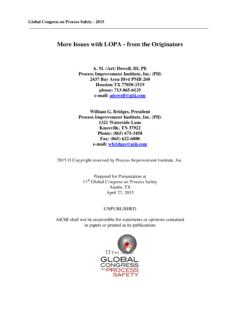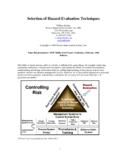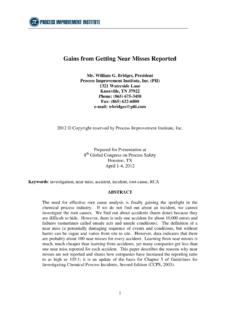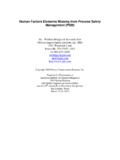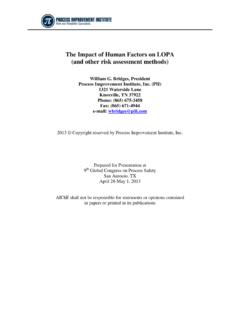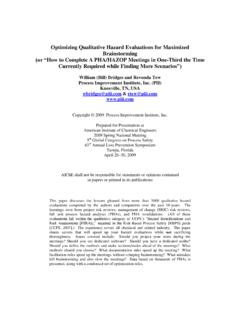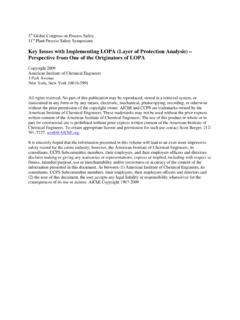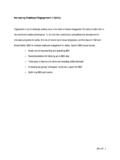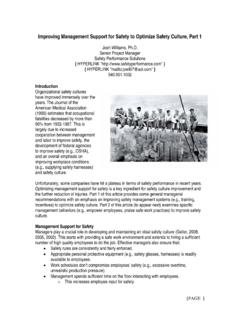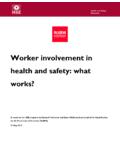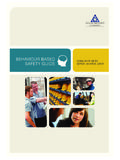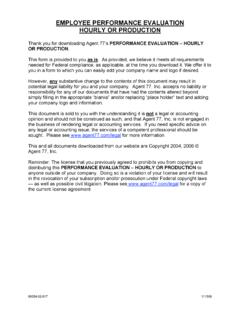Transcription of Process Safety Competency - Process …
1 1 Process Safety Competency - effective approaches to creating and judging Competency on Process Safety Revonda Tew, Senior Engineer; Gerald Burch, Senior Engineer; and William Bridges, Senior Engineer Process Improvement Institute, Inc. (PII) 1321 Waterside Lane Knoxville, TN 37922 Phone: (865) 675-3458 Fax: (865) 622-6800 e-mail: e-mail: e-mail: 2014 Copyright reserved by Process Improvement Institute, Inc. Prepared for Presentation at 10th Global Congress on Process Safety New Orleans, LA March 30 - April 2, 2014 Keywords: Process Safety Competency , Process Safety management, incident investigation, root cause analysis, near miss reporting, Process hazard analysis, human factors, leadership, accountability, employee participation ABSTRACT Process Safety is a deep topic and requires the involvement of nearly ALL staff at a site.
2 But, how do you make sure your staff are up to the task? And how do you judge the Competency of subcontractors or third party experts? This paper describes the basics of building competencies in each aspect of Process Safety , including those tasks that require expert levels of competencies. It shows how different companies plan for the progression to levels of competencies and the typical requirements to reach a new level. One focus of the paper is that Competency cannot be specified (at least not completely). Competency must instead be judged by those who are already competent in that skill or role. 3 Background The increasingly complex and technical demands of Process Safety management (PSM) have placed a large demand on existing resources across the Process industries.
3 Success requires the utilization, involvement, and full support of nearly ALL staff at a site. Success also demands that a substantial portion of staff be competent and capable of contributing. Unfortunately, the Process Safety competencies required for people to become fully involved are not easy to achieve quickly. New engineering graduates may have academic exposure to Safety engineering principles and critical thinking skills, but they generally lack specific training on Process Safety fundamentals, though that is changing in man engineering curriculum. More importantly, new graduated always lack the practical experience required to make sound risk management judgments and they lack the skill required for many tasks in PSM, such as leading Process hazard analyses (PHAs).
4 Similarly, operators and mechanics may have the practical, hands-on experience required, but they often lack the technical skills necessary to perform some of the skill-based tasks that fall to them, and they may also lack the analytical background to evaluate and manage risk effectively. The challenge facing nearly all companies today is how to identify, develop, nurture, and maintain competent individuals across the organization with the right combination of natural abilities, experience, education, and training. Developing, Measuring, and Maintaining Individual Competency Competency is the skill or ability to do something well enough to meet a standard. An individual gains Competency through the combination of natural abilities, general education, experience, and specific skill/task training (classroom and hands-on), as should in Figure 1.
5 Some of these components, such as education or experience (knowledge), can be measured directly and minimum standards established. However, evaluation of the Competency level requires demonstration of the ability and judgment by others who are already competent. How can someone who NOT an expert judge the Competency of someone in a new skill or activity? 4 Figure 1: The Make-Up of Competency in an Individual Process Improvement Institute, Inc. (2013) Progressive Competency levels are achieved over time by participation in specific activities and achievement of specific milestones. Increasing levels of expertise are mastered and maintained through training and mentoring others, cross-functional and cross-departmental sharing of resources and information, stewardship of organizational guidelines and standards, and external engagement with other experts in sharing and developing new knowledge.
6 Figure 2 shows how this progression applies to building Competency in incident investigation / root cause analysis (II/RCA). Two case studies (actual examples from two company) using the model below is provided after the figure. 5 Figure 2: Building Competencies for II/RCA Leadership Process Improvement Institute, Inc. (2013) Case Study: Building Competencies in II/RCA at AMOCO Oil Offshore Business Unit The ratio of near loss incidents to loss incidents reported is a critical leading indicator of Process Safety performance. Near loss incidents provide an opportunity to learn about and correct management system weaknesses before losses are incurred. The desired ratio is 50 to 100 reports of near loss incidents for every loss incident incurred. In 1996, Amoco Oil s offshore business unit on Louisiana (about 650 workers and other staff) determined that an increase in near loss reporting was desired to improve their Process Safety performance.
7 They had historically reported less than 2 near loss incidents per loss incident incurred. First they educated superintendents and managers in how to get near misses reported, including how to create and maintain a blame free environment. This change in management approach included having workers lead all investigations to reduce the fear caused by investigations led by bosses. This changed worked great and the near miss report jumped from the prior ratio to about 80 in one month! (Near miss reporting increased from about 20 a month to about 900 a month, in one month of implementation.) 6 The only way to manage the huge increase in incident investigations was to develop additional resources to participate in and lead investigations.
8 With help from staff now at PII, AMOCO trained about 60 staff (~10% of the work force in that business unit) in the incident investigation and root cause analysis leadership. The training included examples from within AMOCO to add realism and pertinence. Some coaching of new leaders also occurred via phone and e-mail. Then about 9 months later, Refresher training was provided for the 60 leaders, using incidents that they had investigated; this training help make mid-course corrections to the approach/techniques used by the newly trained leaders. These in-house staff carried on the training for many years thereafter. This case study illustrates progression of the II/RCA leaders from the Knowledge level through the Advanced Level (and perhaps Expert Level).
9 Case Study: Building Competencies in II/RCA at A Large Pharmaceutical Company As mentioned earlier, the desired ratio of number of near misses reported to number of actual loss should be 50 to 100 in a company with excellent management systems for Process Safety . This also extends to quality, reliability, and productivity. In 1997, the pharmaceutical company (with more than 50,000 workers and staff world-wide) determined that an increase in near loss reporting was desired to improve their Process Safety performance. They combined all incident databases (there had been 5 different ones) into one database covering reliability, quality, Safety , Process Safety , productivity, and environmental protection. Then, they developed a customized training course (with help from staff now at PII) and trained 7 internal staff of the fundamentals taught in this course; these 7 had been identified as future trainers and they began applying the new methods/approach right away.
10 About a year later, the future trainers appeared expert enough in the methods (as judged by a expert investigator now at PII) and training of 10% of the site staff began across all of the company. Originally, the site staff was trained by the expert at PII, but gradually, the 7 Lilly instructors began to gain skill and confidence in teaching this topic. After about 20 courses in the USA and UK, the training was turned over entirely to the 7 internal trainers. These changes worked great and the near miss report jumped from the prior ratio to about 105 (the highest ratio we have ever measured). This case study illustrates progression of the II/RCA leaders from the Knowledge level through the Advanced and Expert Levels. Developing and Maintaining Organizational Competency An organization gains Competency through the identification and development of the requisite Skills, but skills alone are not sufficient.
